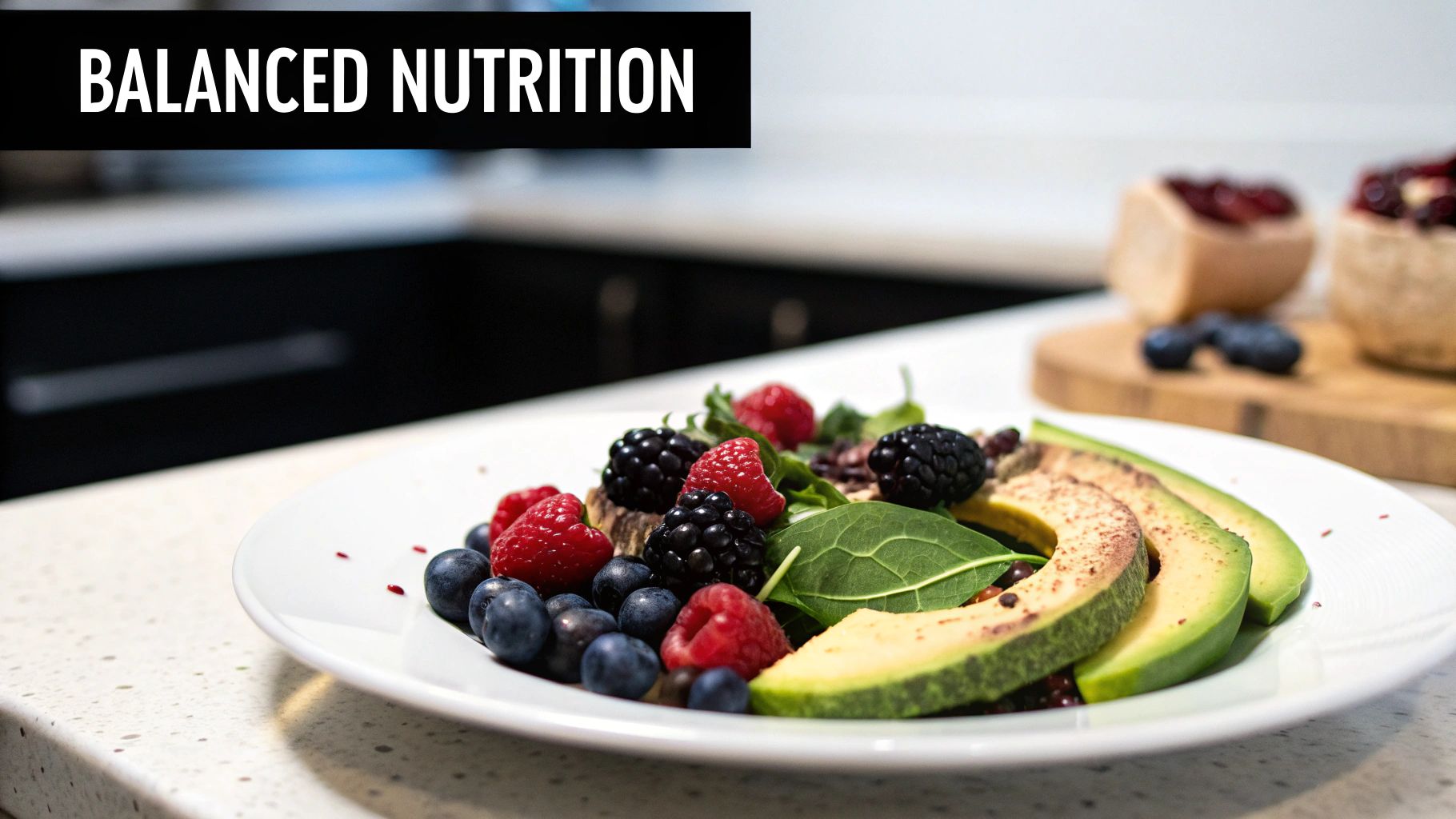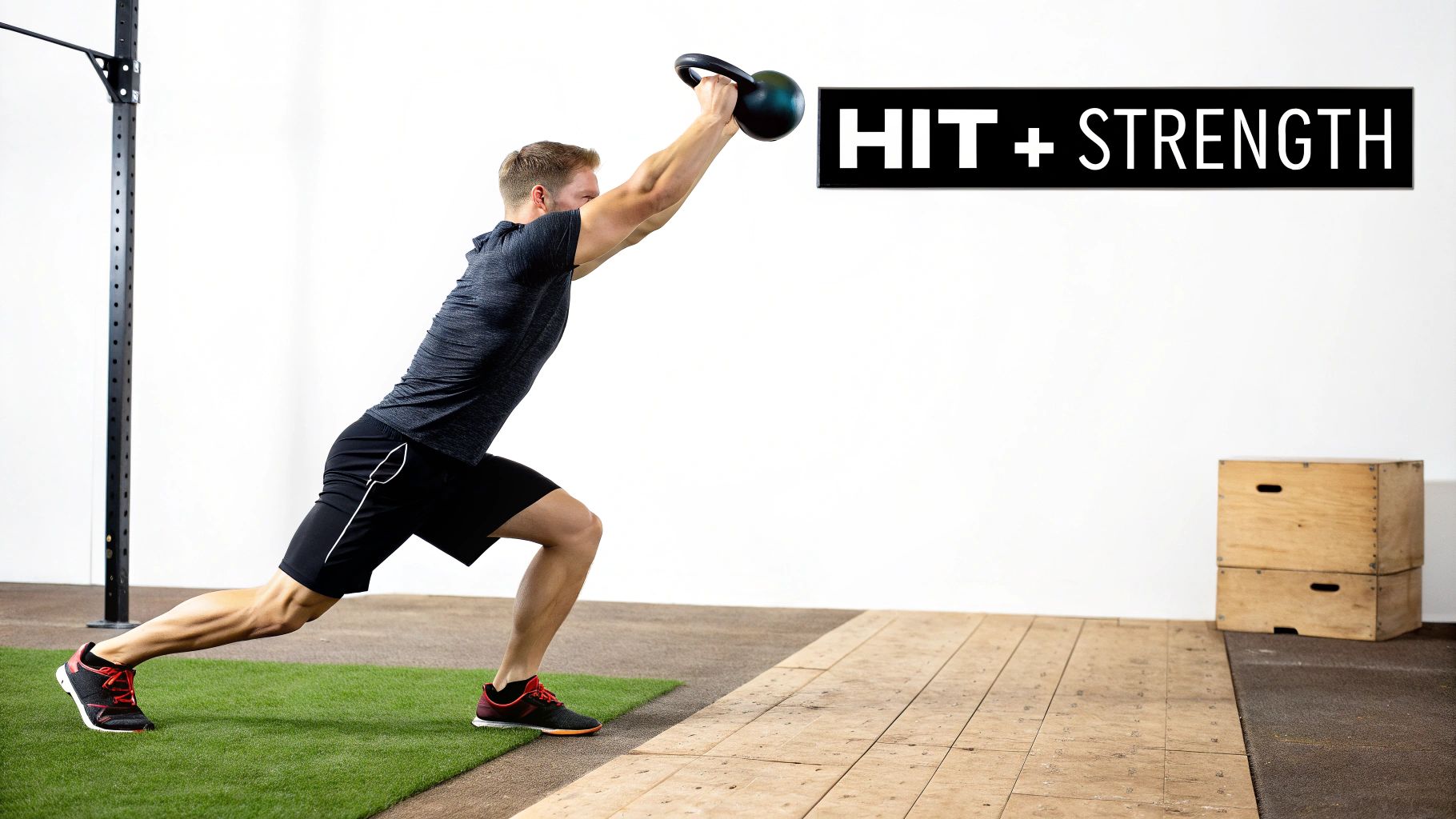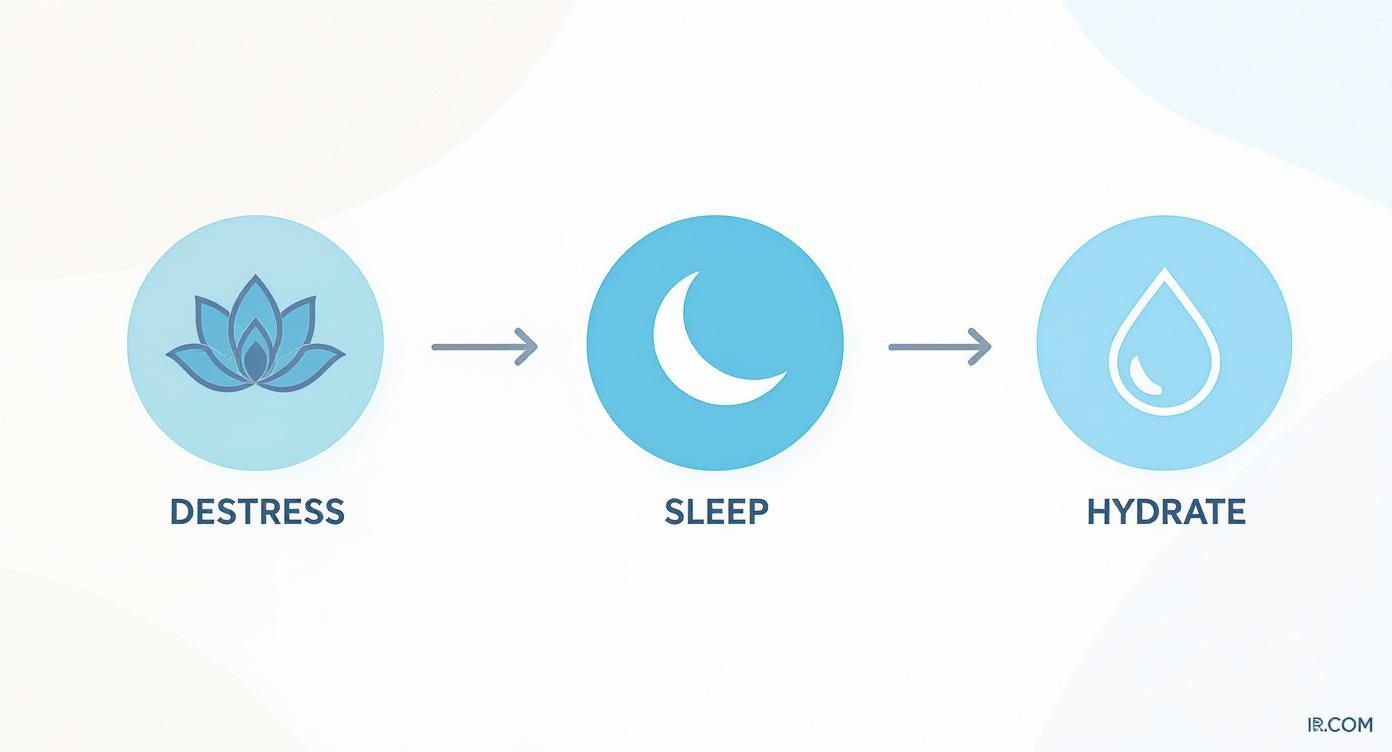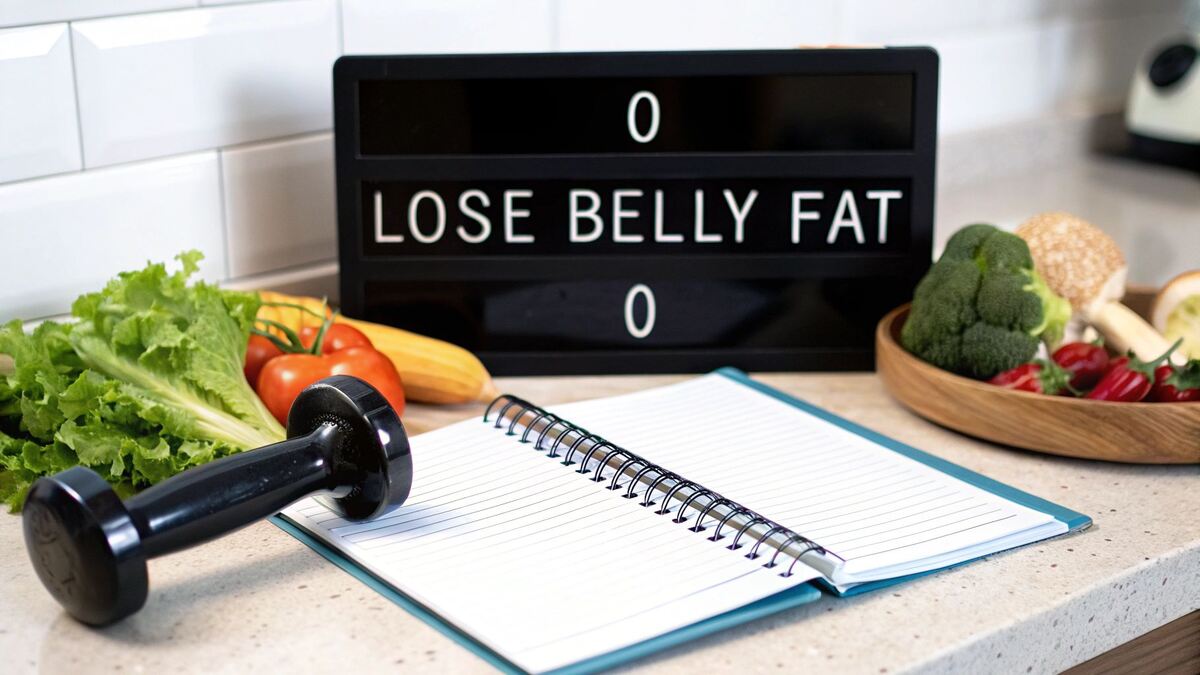How to Lose Belly Fat Fast A Realistic Guide
Losing belly fat isn't just about crunches and salads. The real secret lies in two key areas: creating a sustainable calorie deficit and getting a handle on the hormones that tell your body to store fat right around your middle. If you're looking for a quick fix, you're in the wrong place. Lasting results come from building consistent, healthy habits that tackle the root causes of abdominal fat.
The Truth About Belly Fat and Why It Matters

Before we jump into the "how," it's important to know exactly what we're fighting. Not all belly fat is created equal. It’s actually made up of two very different types.
Subcutaneous Fat: This is the stuff you can pinch—the soft layer of fat that sits just under your skin. While it's what we see in the mirror, it’s not the biggest threat to our health.
Visceral Fat: This is the one we really need to worry about. It’s the deep, hidden fat that wraps around your vital organs, like your liver and intestines. You can't see it, but its presence is a major red flag for your health.
Why Visceral Fat Is a Serious Concern
Visceral fat isn't just sitting there; it's metabolically active. It churns out inflammatory substances and hormones that can seriously disrupt your body's systems. High levels of this internal fat are directly linked to a greater risk of nasty chronic conditions, including type 2 diabetes, heart disease, and even some cancers. Digging into understanding visceral fat and how to reduce it is a critical step in taking control of your health.
This makes losing belly fat less about vanity and more about long-term survival. It’s not just about getting back into your favorite jeans; it’s about protecting your future.
The scale of this problem is massive. The global obesity crisis is growing, with projections showing that the number of adults with obesity could hit 1.13 billion people by 2030. That's a jump of over 115% from 2010. This makes finding effective, sustainable ways to manage weight—especially abdominal fat—more urgent than ever.
A Quick Look at the Game Plan
Here’s a quick overview of the core strategies we'll cover, giving you an immediate look at the key actions needed for real results.
| Strategy | Primary Goal | Key Actions |
|---|---|---|
| Smart Nutrition | Create a sustainable calorie deficit without feeling deprived. | Focus on protein & fiber; limit processed foods & sugary drinks. |
| Targeted Exercise | Boost metabolism and build muscle to burn fat more efficiently. | Combine HIIT (High-Intensity Interval Training) and strength training. |
| Lifestyle Adjustments | Balance hormones (like cortisol) that promote belly fat storage. | Prioritize sleep (7-9 hours), manage stress, and stay hydrated. |
These three pillars—nutrition, exercise, and lifestyle—work together to create an environment where your body can finally start shedding that stubborn fat.
The foundation for losing belly fat fast isn't a secret diet or a miracle workout. It’s about creating a consistent calorie deficit, balancing your hormones through proper nutrition and stress management, and building daily habits that support a healthy metabolism.
The Core Principles That Actually Work
So, how do we put this all into action? The entire approach rests on three foundational pillars that will guide every choice you make from here on out.
A Sustainable Calorie Deficit is Non-Negotiable You simply have to burn more calories than you eat. But—and this is a big but—the deficit needs to be moderate. A crash diet might work for a week, but it’s a recipe for failure.
Keep Your Hormones in Check Stress and lack of sleep are silent killers when it comes to belly fat. They spike cortisol, a stress hormone that practically screams at your body to store fat around your midsection.
Consistency is Everything Real, lasting change comes from the small things you do every single day, not from a drastic two-week blitz. It's the daily habits that compound over time to deliver incredible results.
By focusing on these principles, you give your body what it needs to effectively burn fat, especially that dangerous visceral fat. Let's get into the actionable steps you can take to make it happen.
Building a Nutrition Plan That Actually Works

Let's be honest—extreme diets promising to zap belly fat overnight are mostly hype. Lasting change doesn't come from a quick fix; it starts in your kitchen with a smart, sustainable approach. The goal isn't restriction. It’s about building a way of eating that fuels your body, keeps inflammation down, and supports a healthy metabolism. We're talking about nourishing your body, not starving it.
The good news is that people are catching on. Recent data shows a real shift in obesity trends here in the States. After hitting a high of 39.9% in 2022, the U.S. adult obesity rate has thankfully dipped to 37.0% in 2025. That's a huge deal—it means about 7.6 million fewer adults are living with obesity. It just goes to show that adopting effective strategies, like a solid nutrition plan, makes a real, measurable difference.
Master Your Macros for Fat Loss
To get a handle on belly fat, you need to understand your macronutrients—protein, fats, and carbs. Think of them as tools, not enemies. When you learn how to use them correctly, you can manage hunger, keep your hormones in check, and give your body the fuel it needs to succeed.
Protein is Your Best Friend for Fullness: Ever notice how you stay full longer after a high-protein meal? That's because protein is a powerhouse for satiety. It also takes a bit more energy for your body to digest, giving your metabolism a small but helpful nudge. The takeaway? Include a lean protein source with every meal.
Healthy Fats Keep Hormones Happy: Not all fats are created equal. The healthy kind—found in foods like avocados, nuts, and olive oil—are essential for hormone production and taming inflammation. They also contribute to that feeling of fullness, which is a massive help when you're trying to stick to a calorie deficit.
Choose Carbs That Give You Lasting Energy: Forget the idea that all carbs are bad. Your body needs them for energy. The trick is to choose the right kind. Go for complex carbs like sweet potatoes, quinoa, and whole grains instead of the refined stuff like white bread and pastries. They digest slowly, giving you a steady stream of energy without the blood sugar rollercoaster.
Your Secret Weapon Against Hunger Pangs
One of the most powerful tools you have is fiber. It's a game-changer for controlling your appetite and regulating blood sugar, both of which are critical for shedding that stubborn fat around your middle.
Soluble fiber, in particular, works wonders. It absorbs water and forms a gel in your gut, which slows down digestion. This simple process keeps you feeling full for much longer and prevents those sharp spikes and crashes in blood sugar. When your blood sugar is stable, you're far less likely to crave the sugary, high-calorie snacks that lead to fat storage.
The key to a successful nutrition plan isn't just eating less; it's about eating smarter. Making protein and fiber the stars of every meal will keep you full and your energy stable, making it so much easier to stay in a healthy calorie deficit without feeling miserable.
Powerhouse Foods for Your Shopping List
Building your meals around nutrient-dense, whole foods is the foundation. These are the foods packed with the vitamins, minerals, and compounds your body needs to function at its best and burn fat more efficiently.
Here are a few staples I always recommend adding to your grocery list:
- Lean Proteins: Chicken breast, turkey, fish (especially salmon for its omega-3s), eggs, and legumes.
- Healthy Fats: Avocados, nuts, seeds (chia and flax are great), and extra virgin olive oil.
- Leafy Greens: Spinach, kale, and arugula are low-calorie nutritional superstars.
- Berries: Blueberries, strawberries, and raspberries are loaded with antioxidants and fiber.
- Cruciferous Veggies: Think broccoli, cauliflower, and Brussels sprouts. They're high in fiber and great for your body.
If you're looking for more guidance, diving into a comprehensive healthy meal plan for weight loss can provide the structure and tasty recipes you need to stay on track.
Sample 7-Day Meal Plan to Get You Started
Knowing what to eat is one thing; putting it into practice day after day is another. Here’s a straightforward 7-day plan to get you going. It's designed to create a healthy calorie deficit without overly complicated recipes or ingredients you can't find. And don't forget to drink plenty of water!
| Day | Breakfast | Lunch | Dinner |
|---|---|---|---|
| Monday | Scrambled eggs with spinach & a side of avocado | Grilled chicken salad with mixed greens, tomatoes, & a light vinaigrette | Baked salmon with roasted asparagus & quinoa |
| Tuesday | Greek yogurt with berries & a sprinkle of chia seeds | Lentil soup with a slice of whole-grain bread | Turkey meatballs with zucchini noodles & marinara sauce |
| Wednesday | Oatmeal with sliced almonds & a dash of cinnamon | Tuna salad (made with Greek yogurt) in lettuce wraps | Lean beef stir-fry with broccoli, bell peppers, & brown rice |
| Thursday | Smoothie with protein powder, spinach, & almond milk | Leftover beef stir-fry | Grilled shrimp skewers with a side of mixed vegetables |
| Friday | Whole-grain toast with avocado & a poached egg | Quinoa bowl with black beans, corn, & salsa | Roasted chicken with sweet potato wedges & a side salad |
| Saturday | Protein pancakes with a handful of fresh berries | Chicken and vegetable skewers | Lean steak with a large green salad |
| Sunday | Cottage cheese with sliced peaches | Leftover steak salad | Baked cod with lemon, herbs, & steamed green beans |
Think of this as a template, not a rigid rulebook. Feel free to swap things around based on what you like. For those who want something truly customized, an AI-powered tool can be a lifesaver. You can use this powerful https://ai-mealplan.com/meal-plan-generator to create plans built around your specific goals and tastes.
Strategic Workouts That Burn More Fat

If you think endless crunches are the secret to a flat stomach, you're not alone. It's one of the biggest myths in fitness. The hard truth is you can't spot-reduce fat from your belly or anywhere else. The real key is a smarter workout strategy that torches calories and builds lean muscle, effectively turning your body into a fat-burning furnace.
Your best bet for seeing real, lasting results is a balanced routine. This isn't about spending hours in the gym; it's about making the time you have count. The most effective approach combines two powerful methods: High-Intensity Interval Training (HIIT) and total-body strength training.
The Power of High-Intensity Interval Training
High-Intensity Interval Training, or HIIT, is an absolute game-changer for fat loss. The concept is simple: short, all-out bursts of intense effort followed by brief recovery periods. This method spikes your heart rate and maximizes calorie burn in a fraction of the time it takes to do traditional cardio.
But the real magic of HIIT happens after the workout is over. It kicks your body into a state known as Excess Post-Exercise Oxygen Consumption (EPOC), or the "afterburn effect." Your metabolism stays elevated for hours, meaning you continue burning calories and fat long after you've left the gym.
You don't need fancy equipment to get started. Here are a couple of circuits you can try, aiming to complete each one 3-4 times with a 60-second rest in between.
Bodyweight HIIT Circuit (Great for Beginners)
- Jumping Jacks: 30 seconds
- High Knees: 30 seconds
- Bodyweight Squats: 30 seconds
- Push-ups (on knees if needed): 30 seconds
- Rest: 60 seconds
Advanced HIIT Circuit (Using Equipment)
- Kettlebell Swings: 45 seconds
- Burpees: 45 seconds
- Dumbbell Thrusters: 45 seconds
- Battle Ropes: 45 seconds
- Rest: 60 seconds
HIIT is incredibly effective, but it's also taxing. You only need to work it into your routine 2-3 times per week to see the benefits without risking burnout.
Build Muscle to Burn More Fat
While HIIT is like a blowtorch for calories, strength training is your long-term investment in a faster metabolism. Muscle is more metabolically active than fat. In simple terms, the more muscle mass you carry, the more calories you burn around the clock—even when you're just watching TV.
Forget about isolated movements like bicep curls if fat loss is the main goal. For the biggest metabolic impact, you need to focus on compound movements. These are the big lifts that recruit multiple large muscle groups at once, which burns far more calories and builds functional strength.
The most effective path to losing belly fat isn't endless cardio; it's building a stronger body. Strength training with compound lifts is the most efficient way to increase your resting metabolic rate, forcing your body to burn more fat around the clock.
Make these exercises the foundation of your workouts:
- Squats: The undisputed king of lower-body exercises.
- Deadlifts: A total-body powerhouse for building a strong back and posterior chain.
- Overhead Press: For strong shoulders and a rock-solid core.
- Bench Press: The classic upper-body builder for chest, shoulders, and triceps.
- Rows: Essential for back strength and improving posture.
Aim for 2-3 full-body strength sessions per week on your non-HIIT days. The key is progressive overload—always striving to lift a little heavier, do one more rep, or add another set over time.
Don't Underestimate Steady-State Cardio
With all the hype around high-intensity training, it's easy to forget about good old-fashioned cardio. But moderate-intensity cardio, often called LISS (Low-Intensity Steady-State), absolutely has its place. Activities like brisk walking, jogging, or cycling are fantastic tools.
LISS won't create the same afterburn as HIIT, but it allows you to burn a good number of calories without putting a ton of stress on your body. This makes it perfect for active recovery days. It helps you maintain a calorie deficit without leading to burnout or injury.
Think of it as the reliable foundation of your weekly plan. It's great for heart health, helps manage stress, and contributes to that all-important calorie deficit. Try to get in 30-60 minutes of LISS a couple of times a week, maybe on the days between your tougher workouts.
Sample Weekly Workout Schedule for Fat Loss
Putting these pieces together into a coherent plan is where the results happen. This sample schedule balances high-intensity work with strength training and crucial recovery time.
This table provides a clear, structured workout plan that combines HIIT, strength training, and active recovery to maximize fat burning and muscle building throughout the week.
| Day | Workout Focus | Example Exercises |
|---|---|---|
| Monday | Full-Body Strength | Squats, Bench Press, Barbell Rows, Lunges |
| Tuesday | HIIT Cardio | Kettlebell Swings, Burpees, High Knees (3-4 circuits) |
| Wednesday | Active Recovery | 30-45 minute brisk walk or light cycling |
| Thursday | Full-Body Strength | Deadlifts, Overhead Press, Pull-ups, Glute Bridges |
| Friday | HIIT Cardio | Sprint intervals on a bike or treadmill (8-10 rounds) |
| Saturday | Active Recovery & Mobility | Light yoga, stretching, or a long walk |
| Sunday | Rest | Complete rest to allow your body to recover and rebuild |
This schedule is a powerful template, but always remember to listen to your body. Some weeks you'll feel stronger than others. The goal is consistency over perfection. Finding a routine you can stick with is how you'll finally lose that belly fat and keep it off for good.
Lifestyle Habits That Can Make or Break Your Fat Loss
Your diet and workout routine are the engine of your fat loss journey, but it’s your daily habits that steer the ship. These habits can either accelerate your progress or quietly sabotage it from behind the scenes.
Think of your lifestyle as the environment where all your hard work comes to life. If that environment isn't right, even the most perfect nutrition and exercise plan will stall out.
Let's pull back the curtain on the silent factors that have a surprisingly massive impact on belly fat. These are the behind-the-scenes players—stress, sleep, and hydration—that are quietly pulling the levers on the hormones responsible for fat storage.
Tame the Stress Hormone Cortisol
We all know chronic stress feels bad, but it does more than just weigh on your mind. It has a direct physical impact, and its favorite target is your midsection. When you're constantly on edge, your body floods your system with a hormone called cortisol.
Cortisol was originally a survival tool for "fight or flight" moments. In our modern world, though, it’s always on. This creates a big problem. It constantly signals your body to store energy as fat, and its preferred storage unit is the deep, visceral fat wrapped around your abdominal organs. This is exactly why belly fat can be so ridiculously stubborn, even when you feel like you're doing everything else right.
To fight back, you need practical, real-world stress management techniques. These aren't just fluffy "nice-to-haves"; they are non-negotiable tools for getting your hormones back on your side.
- Mindfulness Meditation: You don't need to be a monk. Just 10-15 minutes a day using an app or simply focusing on your breath in a quiet corner can bring cortisol levels down.
- Deep Breathing Exercises: Feeling that wave of stress? Try the 4-7-8 method. Breathe in for 4 seconds, hold it for 7, and then exhale slowly for 8. It’s like a reset button for your nervous system.
- Leisurely Walks: A slow, gentle walk is incredibly effective. Getting out in nature, if you can, is even better. It lowers stress without adding more physical strain to an already taxed body.
Look, managing stress isn't about eliminating it—that’s impossible. It's about building a toolkit of simple, daily practices that stop cortisol from deciding where your body stores fat.
Prioritize Sleep to Get a Grip on Your Appetite
Sleep is hands down the most underrated tool for losing fat. When you skimp on sleep, even for just one night, you throw your appetite-regulating hormones into total chaos.
Two key hormones are at the center of this storm: ghrelin and leptin. Think of ghrelin as the "go" hormone that screams, "I'm hungry!" and leptin as the "stop" hormone that says, "Okay, I'm full."
When you're sleep-deprived, ghrelin levels shoot up while leptin levels tank. This hormonal one-two punch creates intense cravings for junk food and makes you feel less satisfied even after a big meal. It's a perfect recipe for overeating. The magic number? Aim for 7-9 hours of quality sleep every night to keep these hormones working for you, not against you.
Create a Sleep-Friendly Environment
Getting great sleep starts long before your head hits the pillow. It’s about creating a sanctuary for rest.
- Stick to a Schedule: Try to go to bed and wake up around the same time every day. Yes, even on weekends. This strengthens your body’s internal clock.
- Create a Relaxing Routine: Give yourself 30-60 minutes to wind down. Put the phone away. Read a book, take a warm bath, or listen to some calming music. The blue light from screens messes with your body's production of melatonin, the sleep hormone.
- Optimize Your Bedroom: Make it cool, dark, and quiet. Blackout curtains, an eye mask, or a white noise machine can be game-changers.
This isn't just about looking better. With the global obesity crisis growing, understanding these factors is critical. By 2025, global obesity prevalence is predicted to hit 18% in men and over 21% in women. Alarmingly, this report on global obesity targets shows that very few countries are on track to halt this rise, highlighting just how important it is for us to take proactive steps in our own lives.
The Critical Role of Hydration
Finally, let's talk about water. It’s simple, but it’s powerful. Staying hydrated is non-negotiable for a healthy metabolism.
Water is involved in almost every single process in your body, including the one that breaks down and burns fat. Even being just a little dehydrated can slow down your metabolic rate, which means you burn fewer calories.
Worse yet, our brains often mistake thirst for hunger, tricking us into reaching for a snack when all we really needed was a glass of water. A super simple but effective habit? Keep a water bottle with you all day long.
If you're looking for a structured way to bring all of this together, our weekly meal planner can help align your nutrition with these crucial lifestyle habits. Once you get a handle on your stress, sleep, and hydration, you create the ideal internal environment for your body to finally let go of that stubborn belly fat.
Your Blueprint for Lasting Success
https://www.youtube.com/embed/gljdp6aVJzY
Knowing what to do is the first step, but the real win comes from turning that knowledge into a lifestyle that sticks. This is your guide to getting real, long-term results, making sure you not only lose belly fat but also create a healthier way of life.
The secret ingredient here is consistency, not perfection. You're going to have off days—it happens. Enjoying a slice of birthday cake doesn't undo all your hard work. The trick is to just get right back on track with your next meal or workout. Don't let a small detour derail the entire journey.
Tracking Progress Beyond the Scale
The number you see on the scale is just one part of a much bigger story. In fact, it can be pretty misleading. Daily weight can swing wildly based on things like water retention, hormones, or even muscle gain. To get a true picture of your progress, you need better tools.
- Grab a Tape Measure: Once a month, measure your waist. This is one of the best ways to see if you're losing harmful visceral fat, and you'll often see changes here even when the scale won’t budge.
- Snap Progress Photos: Every four weeks, take a few quick photos from the front, side, and back. Try to use the same lighting and location. The visual proof of your body changing can be a huge motivator.
These methods give you solid evidence that your body composition is improving, which is what really counts.
Navigating Plateaus and Staying Motivated
Sooner or later, everyone hits a weight loss plateau. It's a completely normal part of the process. Your body is incredibly adaptive, and after a while, it gets used to your routine. When the scale stops moving, don’t think of it as a failure—it’s just a sign that it’s time to switch things up.
A plateau isn't a stop sign; it's a signal from your body that it's ready for a new challenge. It’s your chance to fine-tune your strategy, not give up on it.
Try adding a little more intensity to your HIIT workouts, or maybe introduce a few new strength exercises you haven't done before. On the food front, double-check that your portion sizes haven't slowly started creeping up. If you need some fresh ideas, you can always explore different AI-generated meal plans to get new recipes and nutrient mixes to help kickstart your progress again.
This visual really drives home how simple daily habits—like managing stress, getting enough sleep, and staying hydrated—are all connected in your fat loss journey.

The big takeaway is that all these pieces work together. If you ignore one, you weaken the others. By focusing on the whole picture—smart tracking, overcoming setbacks, and staying consistent—you're not just losing weight; you're building a sustainable lifestyle that keeps belly fat away for good.
Answering Your Top Questions About Belly Fat
Let's be honest, the internet is full of conflicting advice on how to lose belly fat. It's confusing. I want to cut through that noise and give you some straight, science-backed answers to the questions I hear most often.
So, How Long Does It Really Take to Lose Belly Fat?
There's no one-size-fits-all answer here. Your starting point, genetics, and how consistently you stick to a plan all play a huge role.
A healthy and realistic goal is to aim for losing 1-2 pounds per week. At that pace, you'll likely start to feel a difference within a few weeks, and more noticeable visual changes often appear after a month or two. Be wary of any program promising you'll lose weight faster than that—it's usually not sustainable and you risk losing muscle, not just fat.
Can Certain Foods Actually Target Belly Fat?
I wish I could tell you there's a magic food that zaps belly fat, but the idea of "spot-reducing" fat with diet is a complete myth. You can't pick and choose where your body loses fat from.
What you can do is create an overall fat-burning environment with the right foods. A diet that helps reduce total body fat (including the dangerous visceral fat around your organs) is your best bet. Focus on incorporating:
- Soluble Fiber: Things like oats, beans, avocados, and apples keep you feeling full and help manage blood sugar.
- Lean Protein: This is crucial for staying satisfied and holding onto muscle while you're eating in a calorie deficit.
- Healthy Fats: Think nuts, seeds, and olive oil. These help regulate hormones and fight inflammation.
The real strategy is a balanced diet built on whole foods, not a single miracle ingredient.
The truth is, you can't spot-reduce fat with food or exercise. The most effective approach combines full-body strength training to fire up your metabolism with high-intensity workouts to burn more calories. That's the real key to lowering your overall body fat, which naturally includes your midsection.
Do I Have to Do a Million Crunches Every Day?
Please don't! While crunches and sit-ups will build your ab muscles, they do next to nothing for burning the layer of fat sitting on top of them. Spending all your time on crunches is a really inefficient way to chase a flatter stomach.
Your time is much better spent on exercises that give you more bang for your buck metabolically. Compound movements are your best friend here—think squats, deadlifts, and overhead presses. They work multiple large muscle groups at once, which torches way more calories and builds the kind of muscle that keeps your metabolism humming.
Pair those with a couple of high-intensity interval training (HIIT) sessions each week, and you’ve got a powerful fat-burning combination.
Ready to stop guessing what to eat? AI Meal Planner can design a custom meal plan that fits your exact goals and food preferences, taking all the confusion out of the equation. Get your personalized plan today at https://ai-mealplan.com.
AI-powered nutrition
Get Your Personalized Meal Plan
AI creates the perfect meals for your goals, lifestyle, and taste.
Start Your Journej
